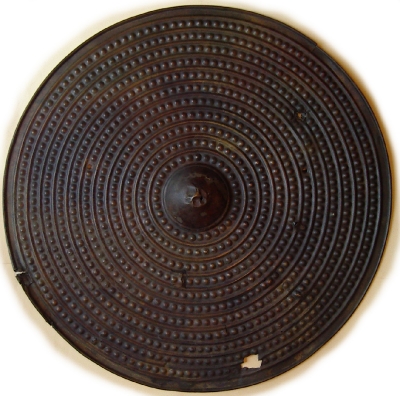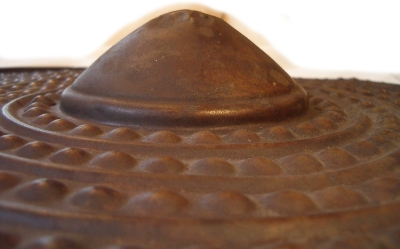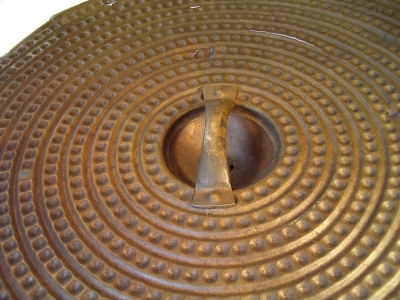To search the RPR site click here
Found, lost and Found again [Add.9455vol1_p19 /13]
Marion Uckelmann
The following narrative tells the fascinating story of a Bronze Age shield which was found in the Thames in 1864. Within in a few years it was considered to be lost, but fortunately has just been rediscovered.
The first mention of the shield is in the Gentleman’s Magazine, December 1865, where Mr A.C. Kirkmann gives a detailed description of the matter:
ANCIENT BRITISH SHIELD. Sir,—During the very low water in the Thames in the month of September, 1864, a boatman perceived in the bed of the river between Hampton and Walton a round object, the nature of which he was at first unable to discern, but using his boat-hook for some time he brought to the surface the bronze shield a drawing of which I send you. [...] The discovery of this relic adds one more to the three examples already known. Two have been found in Wales and one previously in the bed of the Thames. It is ornamented with twelve concentric circles, which, like the nineteen found on the Welsh types, may or may not have an astronomic reference. Between each circle is a number of studs, but these are larger and less numerous than those on the Welsh shields, and differ materially from the one previously found in the Thames, so that the specimen is altogether unique.
Mr Kirkmann was a collector of prehistoric objects and his collection was well known during his lifetime. However, the shield did not belong to his collection, but to an acquaintance of Mr Kirkmann: Mr James Milner. Mr Milner is well documented on censuses etc. as living at that time in Palace Road, East Molesey, Surrey which is less than 5 km from the find spot of the shield. The next published record on the shield is a short description in the Proceedings of the Society of Antiquaries of 1867 (Tayler 1867), but this gives no clue of its whereabouts. The shield was exhibited at the National Exhibition of Works of Art, in Leeds in 1868. Mr Milner presented the shield there, probably due to his origins in Leeds and where his wealthy family still resided. This is the last time the shield is mentioned with a certain provenance and as belonging to Mr Milner.
The next references in the literature cite only Kirkmann’s description. In 1872 Augustus Wollaston Franks asked in a short note on shields, again in the Proceedings of the Society of Antiquaries:
“It would be desirable to know what has become of the shield found in the Thames in 1864” (Franks 1872, 364).
Thereafter the shield is labelled as lost or with unknown whereabouts (Evans 1881, 352; Smith 1919, 150; Sprockhoff 1930, 14 no. 33; Coles 1962, 87 no. 4).
The above is all that was known about the shield until recently. Various bits of information were gathered together by two local historians, Paul Gossage and Steve Baker, who initiated the new search and the author, who had just finished her PhD on the European Bronze Age shields. With their combined forces it was possible to relocate the shield. The following pieces of information were put in chronological order:
In the inventory books of the private second collection of Augustus Pitt-Rivers (assembled after 1880), which can now be accessed following the database link on the right hand menu of this site, there is an entry of a shield purchased by him at the 17th May 1882 from a Mr William Wareham, London. This shield is described as
Circular Bronze Shield […] 25 inches in diameter […] found in the Thames at Halliford nr: Walton-on-Thames” (Add.9455vol1_p19 /13).
Undoubtedly this is the same shield owned before by Mr Milner. The shield became part of Pitt-Rivers’ private collection. First it was taken to the family home, Rushmore, and later displayed in the Pitt-Rivers Museum in Farnham, Dorset.
It is interesting to note that a very famous painting of Pitt-Rivers, created by Frank Holl in 1882, shows a shield lying at the feet of the General. Although it is largely idealized, the shield pictured is almost certainly the one purchased shortly before the painting was done. It was the only Bronze Age shield of this kind in his collection and is evidence for the high regard in which he held it.
We are deeply indebted to Hannah Jeffery, the librarian of the Surrey Archaeological Society, who diligently researched her archives and was able to unearth recently an article by W. E. Phillips on Bronze Age metal objects in Surrey, which was unfortunately overlooked for a long time. She brought it to the attention of Paul Gossage, and this turned out to be the missing link in our quest that led to the Pitt-Rivers archives and the solving of the mystery.
Phillips also states that the shield was held in the Farnham Museum: “A shield dredged up from the river bank at Walton-upon-Thames is circular and approximately two feet across. Its decoration consists of concentric rings of small repoussé bosses and raised ribs (Footnote 67: Now in the Pitt-Rivers Museum, Farnham, Dorset). It is of Type Yetholm and similar to one from Moel Siabod” (Phillips 1967, 8. 30) which is now in the British Museum.
This private collection stayed in the Pitt-Rivers family until the 1950s and 1960s when the objects were sold individually to different people. Around the 1960s/70s John Hunt bought some items from the Pitt-Rivers collection that had been in the former museum in Farnham; namely a bronze bucket, cauldron and shield, all of them are now on display in the Hunt Museum in Limerick, Ireland. John Hunt did not know the provenance of the shield. He assumed that the shield was connected with the bucket and cauldron bought by Pitt-Rivers in the 1890’s, being before a part of the collection of T.W.U. Robinson, and sold through Sotheby’s. The cauldron from Ballyscullion (Add.9455vol2_p651 /1) and the bucket from Cape Castle (Add.9455vol2_p650 /9) were already well documented (Evans 1881, 411 Fig. 511; 412 f. Fig. 513) and their provenance clear. Since they were both from north-east Ireland, the shield was assumed to be from the same area and hereafter labeled as from Co. Antrim (Doran 1993, 44 Taf. 38; Fernström 1995, 3–20).
Through the reference in Phillips and the registration books of Pitt-Rivers it now became clear that this shield from “Co. Antrim” is the one that was found in 1864 in the Thames between Walton-upon-Thames and Hampton.
The shield is of circular form and measures 63.8 cm in diameter. It was hammered out of a blank into a bronze sheet, which is c. 0.5 mm thin and weighs 1484 g. It is decorated with eleven concentric rows of punched-in bosses, alternating with eleven concentric ribs, as well as an additional rib before the rolled over rim. Under the conical central shield boss a grip is fastened, with a rivet on each end. The body of the shield bears two holes where tabs were once attached, so the shield could be carried over the shoulder by a strip of leather or band or a wire. The hammering of the blank into a sheet was a time intensive and delicate work process, which included many rounds of hammering and annealing the metal (at ca. 500–700°C), which would turn brittle otherwise. In experiments it was possible to cast blanks as large as 19 cm. After each annealing the blank was quenched in water and then hammered to stretch it. This was a slow process in which the metal was stretched by 1-2 mm per round of hammering. Therefore, a number of at least 200 rounds of hammering and annealing has to be assumed; this large amount of cold working is also evidenced in metallographic analyses of some shields. (Uckelmann forthcoming).
The shield belongs to the Type Yetholm, of which 22 have been preserved, some only in fragments. Seven to eight are known from written sources but are lost today. This makes this type the largest of all Bronze Age shields, as only about 85 metal ones are known from across Europe. The Yetholm shields are all, except one from Denmark, found in the British Isles: 15 from England, nine to ten from Scotland, and two each from Wales and Ireland. They were mostly found in wet contexts, mainly in bogs with fewer in the great rivers Thames and Shannon. In closer comparison with other finds from wet and dry contexts, these shields can be interpreted as votive offerings. Since they were found on their own or in combination with other shields the dating is difficult, but can be generally placed in the Late Bronze Age (Uckelmann 2011; forthcoming). The newly discovered shield from South Cadbury (Coles et al. 1999) is the only shield that was discovered during an excavation. It was found in a trench and the pieces of ceramic and bones as well as the metal alloy suggest a date into the Penard/Wilburton phases (c. 1300–1000 BC).
The bronze shields were valuable and elaborately worked objects, and had their own meaning in the martial environment of the Bronze Age people. They were clearly used but not simply for a single purpose. During the ‘lifetime’ of the shield it went through different stages in its meaning and function. In the beginning it would be the precious product of a well-skilled and trained craftsman. In its time of active use, some of the metal shields very probably protected their bearer in combat and were also used as markers of a social position and/or as a device in ritual ceremonies. After their time of active use, their function changed and they were transferred or rather offered – most likely by the community – to another sphere (Uckelmann 2011, 198).
There they remained, in this case in the Thames, until they were found by adventurers, archaeologist, fisherman or workmen cutting peat, dredging or labouring in the fields, when they captivated the eyes of modern men. Like the shield from the Thames found between Walton-upon-Thames and Hampton, many of them were treasured by their owner, placed in exhibitions and precious collections. Even though this shield was under a wrong name for a long time, it has lost nothing of its allure and is displayed nobly in the Hunt Museum just as the previous owners Mr Milner and General Pitt Rivers had envisioned.
References
National Exhibition of Works of Art, Leeds 1868. Official catalogue, published by the executive committee. Leeds: Edward Baines and Sons 1868 [p. 185 no. 83].
Coles, J.M. 1962. 'European Bronze Age Shields'. Proceedings of the Prehistoric Society 28, 1962, 156–190.
Coles, J.M., P. Leach, S.C. Minnitt, R. Tabor, A.S. Wilson, 1999 'A Late Bronze Age shield from South Cadbury, Somerset, England'. Antiquity 73, 1999, 33–48.
Doran, P.F. 50 Treasures from the Hunt Collection (1993).
Evans, J. 1881. The ancient bronze implements of Great Britain and Ireland (London).
Fernström, M. 1995. The Antrim Shield. Hunt Museum, Docent Program (unpublished) 1–20.
Franks, A.W. 1872. (exhibitions and communications). Proceedings of the Society of Antiquaries (London) Nov. 1872, 360–365.
Kirkmann, A.C. 1865. 'Ancient British Shield'. The Gentleman’s Magazine, December 1865
Phillips, W.E. 1967. 'Bronze Age metal objects in Surrey'. Surrey Archaeological Collections, vol. 64, 1967, 1–34.
Smith, R.A. 1919.'Circular bronze shields'. Proceedings of the Society of Antiquaries (London) 31, 1919, 145–151.
Sprockhoff, E. 1930 'Zur Handelsgeschichte der germanischen Bronzezeit'. Vorgeschichtliche Forschungen 7 (1930).
Tayler, W. 1867. Proceedings of the Society of Antiquaries 1864–1867 (June 1867), 518.
Uckelmann, M. 2011. 'The function of Bronze Age shields'. In M. Uckelmann and M. Mödlinger (eds), Warfare in Bronze Age Europe: Manufacture and use of weaponry. BAR International series 2255, 187–199. Oxford, Archaeopress
Uckelmann, M. forthcoming (2011/12). Die Schilde der Bronzezeit in Nord-, West- und Zentraleuropa. Prähistorische Bronzefunde III, 4. Stuttgart, Steiner.
We are very grateful to Marion Uckelmann for allowing us to use her photographs of the shield on the site with the courtesy of the Hunt Museum, Limerick.
October 2011.







